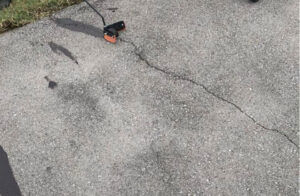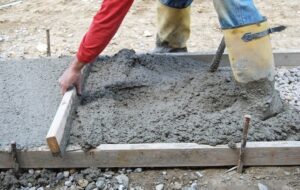Driveway Repair Charles Town WV rather than replacing it is a cost-effective way to improve curb appeal and reduce the risk of tripping hazards. However, you must identify the source of the problem and choose the appropriate repair method.

Isolated cracks and holes can usually be repaired using patching. However, if you have damage covering more than 25% of your driveway, resurfacing is the way to go.
If left unchecked, driveway cracks can spread and cause further damage to your vehicle or home. It’s important to repair these cracks as soon as they appear to avoid future problems.
Depending on the type of crack, there are different repair methods. Hairline cracks are usually surface-level and appear as fine lines that run horizontally across the driveway. These are cosmetic in nature and can be fixed with a concrete patch or asphalt repair product. Wide fissures are typically deeper in the pavement and indicate an underlying problem. This can be caused by loose soil, a poorly compacted base layer or heavy vehicles. Repairing this can be a more involved process that involves grinding the affected area, removing and replacing the material, then applying an overlay to ensure the new section blends in with the existing surface.
These cracks can also be caused by poor curing, especially if the concrete mix was subpar. This can cause the surface to lose moisture and weaken the materials. Alternatively, cracks can be caused by water seepage through the cracks or pores of the concrete, which freezes and thaws repeatedly, causing additional stress to the surface.
To repair these cracks, you’ll need to prepare the affected area by sweeping and cleaning it, making sure to remove any dirt or weeds in the cracks. Choose a sunny day to begin the repairs so the crack filler can warm up and soften. Use a crack filler with a high percentage of self-leveling properties that will make it easy to apply a smooth, even coat to the cracked surface.
Once the cracks have been repaired, you should wait four to eight hours before sealing the area. If you’re using a concrete driveway repair kit, be sure to follow the directions carefully. It’s important to not overfill the cracks, as this will show through the finished sealant.
It’s possible to take preventive steps to reduce the amount of cracking in your driveway, such as ensuring that the concrete mix was of high quality and that it was properly compacted during construction. However, even the best constructed concrete can be prone to cracking over time. The more proactive you are about repairing these cracks, the longer your driveway will last without the need for expensive resurfacing.
Potholes
Potholes can be very dangerous for drivers as they pose a threat to vehicle tires. They can also cause damage to the driveway itself. If you notice a pothole in your driveway it is important to fix it as soon as possible. Doing so will prevent your car from getting damaged and help protect the overall integrity of your driveway.
Typically, potholes form in dirt or gravel driveways as a result of water displacement. The water can be caused by groundwater or rainwater drainage problems. As the water changes temperature it will expand and contract, displacing the aggregate in the driveway. This will leave a compacted ring in the surface of your driveway that can become larger and deeper over time.
If you have a dirt driveway it is important to fill the potholes with coarse gravel. Then tamp it down with a steel tamper or 4×4 wood post to make sure the gravel is compacted well. You should then rake the gravel to blend it with the rest of your driveway. If you have a gravel driveway that has developed some corrugations, you may need to grade the entire surface to restore the smoothness. If the corrugations are very deep, a complete resurfacing will be required.
For asphalt driveways that need to be repaired, you can use a cold patch material. First, it is important to make sure the area is clean of any dirt, dust or water as this can keep the asphalt patch from adhering. You should then heat the area with a flame torch to soften the existing asphalt and help it bond with the new cold patch.
Once you have filled the potholes with your chosen material it is important to tamp it down again using the same technique used with the gravel. This will ensure that the patch is compacted well and won’t create more potholes in the future. If you do a good job on your potholes they will disappear and your driveway will look as if they were never there. However, if you just perform a quick patch job they will come back in the future and you will need to repair them again.
Unevenness
Concrete might seem sturdy and indestructible, but heavy foot traffic and vehicle weight take their toll on driveways and sidewalks over time. As a result, they can begin to crack and become uneven. Uneven concrete can present a number of problems, and it should be dealt with immediately. Uneven concrete may cause damage to your vehicle, as well as creating tripping and falling hazards on your property. These hazards are particularly dangerous for people who have disabilities, mobility issues, or poor vision, and they should be addressed as soon as possible.
A cracked or unlevel driveway can also put excessive stress on your car’s suspension system, causing it to wear out faster than it should. This can lead to expensive repairs, but a few simple steps can help ensure that your car is safe and comfortable to drive for its entire life.
Uneven concrete is often caused by soil erosion or washout. When the soil is unhealthy, dehydrated, or very saturated, it can wash away and leave gaps beneath surfaces like concrete slabs and driveways. Over time, these gaps can fill with water and cause the surface to sink.
If your driveway or sidewalk is made of loose materials, like gravel or stone, it’s especially prone to becoming uneven over time. Loose stones shift under the weight of vehicles and wash away when it rains, leaving bare spots and potholes. Thankfully, these types of unevenness are easy to fix by raking and shovelling the loose material back into place.
Uneven driveways can also be fixed by resurfacing or repairing the affected areas. Resurfacing the entire driveway will result in a more even and attractive surface, while targeted repair and resurfacing can be used to fill cracks, patch potholes, or adjust slope gradients. In more severe cases, reconstruction can be necessary.
Whether you’re dealing with minor cracks, major potholes, or sunken concrete, a professional can provide creative and effective solutions. They can use a variety of methods, including mudjacking (which involves drilling holes the size of soda cans into settled concrete and pumping a cement slurry into them to lift the slabs), to mechanically lifting the slabs and filling underneath to prevent further settling.
Weeds
Weeds are unsightly, and they can also damage your driveway. If left unchecked, weeds will fill in cracks and create a soft surface that allows grass or other plant roots to push through. As a result, the roots will cause the pavement to crack further and may eventually detach or dislodge the paving stones from the base. Weeds should be removed regularly, especially in spring or fall, when germination is at its highest.
Many home improvement stores carry a variety of herbicides that are effective for killing annual or perennial weeds and grasses in pavement. However, if you are concerned about the impact these chemicals can have on soil and other plants around your property, you can try a natural weed killer. Mixing horticultural vinegar (20 percent acetic acid) with a little orange oil and a bit of phosphate-free dish soap makes an effective weed killer that you can spray directly on your driveway. Wear a face mask and gloves when handling the vinegar solution because it can burn your skin and eyes. Apply the solution to your weeds, making sure it saturates all parts of the exposed plant, including the roots. After spraying, wait a day or two to ensure the weed is dead. If you see a resurgence of the weed, spray again until it is gone.
You can also use a garden tool such as a screwdriver to loosen the soil surrounding the weed. Once it is loose, you can lever out the entire weed, roots and all. However, this method is only effective if you remove the weed as soon as it emerges and is not allowed to grow back.
Another option is to pour a salt solution over the weeds and then hose them down. You can also use a spray bottle filled with a mixture of salt and white vinegar (5 percent acetic acid) to kill the weeds and prevent them from growing back. However, if you use this method, be careful not to get the salt in areas of your landscape where desirable plants may grow. The salt can also contaminate the soil and prevent it from supporting healthy growth. You can also use baking soda as a natural weed killer. Pour it over the weeds, being careful to avoid getting it on your driveway or in soil that you want to grow something in.
